All Rights Reserved, 2000 - 2017
Created by:
Torrence Royer
Comments are welcome.
Please leave a note in the public GUEST BOOK
or send a private Email to:
Barghash@msn.com

Zanzibar and the Great War
On
the
eve
of
the
First
World
War,
Zanzibar
Town
stood
near
the
top
of
African
Cities.
In
1914
its
infrastructure
including
harbor
facilities,
communication
networks
and
housing
resources,
were
clearly
aspiring
to
make
it
a
modern
city.
In
terms
of
human
resources
its
people
were
known
for
their
industry,
diversity
and
sophistication,
the
city
was
sometimes
referred
to
as
"the
Paris
of
Africa."
The
government
operated
on
a
dual-rule
model
with
the
Sultan
administering
some
facets
of
trade,
civil
order
and
Islamic
laws;
while
the
British
controlled
the
most
important
city
services,
the
military,
and
tax
collection.
In
the
two
decades
since
the
1896
shortest
war
Britain’s
connection
to
Zanzibar
had
been
secured
and
expanded
into
a
working,
if
uneven
partnership.
As
war
clouds
began
to
gather
in
Europe
that
solemn
November,
the
Islands
and
especially
the
Stone Town environs were solidly in the British camp.
Word
of
the
declaration
of
War
between
Germany
and
Great
Britain
was
flashed
to
Zanzibar
almost
instantly
via
the
underwater
telegraph
cable
that
had
been
laid
to
Stone
Town
from
Aden
in
1900.
When
the
Zanzibari
and
British
leadership
meet
to
review
the
situation,
they
found
their
prospects
grim.
The
leaders
first
lamented
the
almost
complete
lack
of
mainland
coastal
defenses
save for the ancient Fort at Mombasa. Then the British military report noted:
"Even
more
anxious
was
the
situation
in
Zanzibar
for
that
Island
with
no
fixed
defenses
lay
within
20
miles
of
the
German
coast
....
a
wealthy
seaport
....
Zanzibar
was an obvious objective for the enemy."
The Land Forces:
Young
men
from
the
Zanzibar
area
were
first
enrolled
in
by
the
British
army
into
a
single
regiment
named
the
East
African
Rifles.
In
1902
this
unit
was
reorganized
as
the
3rd
Battalion
of the newly created
Kings African Rifles.
The
original
compliment
for
3rd
Battalion
called
for
900
men;
“300
Punjabis,
100
Sudanese,
300
Swahilis
and
a
‘mixed
force’
of
200
men.”
It
is
from
among
the
last
two
categories that the Zanzibari men would have been recruited.
Just
a
small
detachment
of
the
3rd
battalion
was
on
Zanzibar
that
August,
about
115
men.
The
bulk of the unit was posted on the mainland, and far to the north.
The
only
other
troops
in
Zanzibar,
when
the
war
started
were
the Sultan's Palace guard.
Perhaps
the
only
positive
note
was
the
readiness
of
the
local
police
constabulary
in
Zanzibar.
It
was
thought
that
these
well
trained
men
might
serve
as
non-commissioned
officers
in
a
locally
recruited civil
defense force.
For
the
their
immediate
needs
however,
the
British
looked
to
the
Indian
Army
to
supply
men
for
the
defense
of
East
Africa.
They
also
looked
to
the
Royal
Navy
to
block
any
invasion
threat
to
Zanzibar. Both of these plans were to be sorely tested in the coming fight.
On
the
German
side,
the
local
land
forces
were
more
ready
for
war.
The
German
equivalent
of
the
KAR
was
the
Schutztruppe.
Established
in
1889
this
force
had
25
years
of
experience
fighting
on
home
ground.
They
gained
battle
experienced
during
numerous
coastal
uprising,
including
the
Abushiri
Rebellion,
1888-1890,
the
HeHe
War,
1891-1898,
and
the
Maji-Maji
Revolt,
1905-1907.
However
they
lacked
the
ammunition
and
material
needed
to
fight
a
protracted
war.
Without re-supply they seemed unlikely to last long.
Besides
the
direct
military
threat
there
was
also
a
concern
on
Zanzibar
about
political
unrest.
Most
Zanzibaris
had
no
love
for
the
Germans,
due
partly
to
the
many
abuses
and
the
occasional
sacrileges
reported
by
their
coastal-mainland
cousins.
Still,
there
was
a
minority
who
might
be
spurred
to
action
if
the
war
went
well
for
the
Germans.
The
same
British
report
noted
this
threat,
"...a
further
risk
lay
in
the
fact
that
Sayyid
Khaled,
deposed
from
the
sultanate
...
years
earlier,
was
living
in
(German
controlled)
Dar-es-
Salaam and could claim many sympathizers in Zanzibar."
Opening Acts near Zanzibar:
One of the first acts of this first global conflict occurred in Zanzibar.
Upon
receiving
the
war
alert
on
August
4th
1914
a
Port
Official
on
duty
at
the
Zanzibar
Harbor
ordered
the
Zanzibar
police
there
to
seize
the
German
registered
Sea
Tug
"Helmuth"
which
was
anchored
near
the
German
embassy.
This
ship
was
the
only
German
vessel
then
in
Zanzibari
waters.
The
seizure
of
the
Helmuth
effectively
cut
off
the
only
escape
route
for
a
number
of
German
nationals
living
in
the
city.
Most
of
these
civilians
were
interned
for
a
time
and
then
repatriated safely.
In
these
first
days
of
the
war
there
was
a
great
zeal
to
take
the
fight
to
the
enemy
wherever
he
could
be
reached.
On
August
8th,
while
Europe
still
mobilized,
the
very
first
naval
action
of
World
War 1 occurred when the H.M.S. Astrae raided the Dar es Salaam Harbor.
The
Astrae
destroyed
the
wireless
station
with
shell
fire
and
then
sent
boarding
parties
onto
two
anchored
German
merchant
vessels,
scuttling
them
both.
The
Germans,
fearing
that
the
British
might
seize
and
use
the
Harbor,
then
themselves
sank
an
additional
ship
(The
S.S.
Konig)
in
order
to
plug
the
harbor entrance.
World War One on the East African Coast
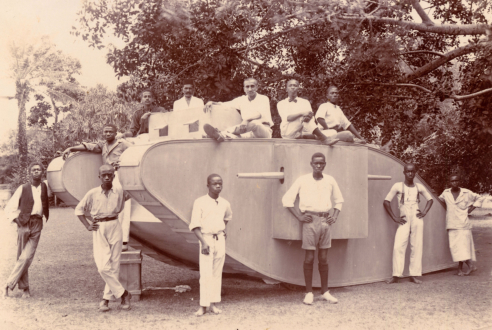
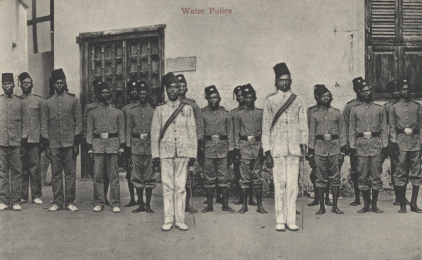
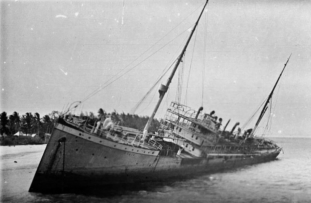
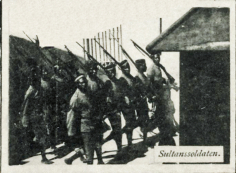

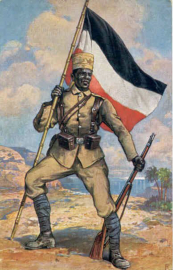
The
next
fortnight
was
spent
by
both
sides
in
organizing
and
building
up
their
defenses.
The
Germans
in
Dar
es
Salaam
continued
to
worry
about
a
British
attempt
to
seize
that
city
while
the
British worried about possible attacks on Zanzibar and/or Mombasa.
It
was
during
this
time
when
both
sides
made
efforts
to
recruit
local
coastal
residents
and
form
volunteer
militia
units.
The
four
units
most
affiliated
with
Zanzibar
and
the
Mrema
Coast
were:
*the
Zanzibar
Rifles
,
*the
Mafia
Riles
,
*
Wavell’s
Arabs
and
*the
Arab
Corps
.
Three
of
these
units
fought
for
the
British
side.
only
one,
the
‘Arab
Corps’
supported
the
Germans.
The
Arab
Corps
was raised in Dar es Salaam with the help of the ex-Sultan of Zanzibar Kaylid bin Barghash.
These
formations
were
all
infantry
units
and
all
would
soon
take
part
in
the
fight,
but
first
a
naval
battle in Zanzibar Harbor would grab the world’s attention.
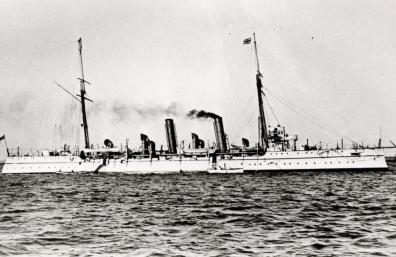
The sinking of the HMS Pegasus
After
H.M.S.
Astrae
shelled
Dar
es
Salaam
she
moved
south,
away
from
Zanzibar.
That
left
her
sister
ship,
the
H.M.S.
Pegasus,
as
the
only
war-ship
in
Zanzibar
waters.
The
Pegasus
too
was
eager
to
take
the
fight
to
the
enemy,
on
Aug.
17
she
raided
the
German
held
port
of
Tanga,
(and
disabled
the
German
merchant
ship
Markgraf).
On
August
26th
she
raided
the
mainland
town
of
Bagamoyo.
The
ship
then
retired
to
a
defensive
posting
in
the
Zanzibar
harbor.
After
3
weeks
of
waiting
the
captain
decided
it
was
a
good
time
to
clean-out
her
coal
fired
engines.
With
her
engines
off-line
she
was
presented
a
sitting
target
for
the
best
warship
in
East
Africa
at
the
time,
the
S.
M.
Konigsberg.
That
German
light-cruiser
came
rushing
through
the
“French
Pass”
approach
to
Zanzibar
City
on
the
morning
of
Sept.
20.
1914.
She
opened
fire
with
guns
that
were
more
accurate
and
had
a
longer
range
than
anything
the
British
had.
In
less
than
10
minutes
the
stationary
Pegasus
was
a
burning wreck. The British captain (Commander John Ingles) struck his flag, indicating surrender.
The
Konigsberg
reversed
course,
began
laying
mines
near
the
harbor
(mines
which
proved
to
be
imitations)
and
then
sailed
away,
without
making
any
attempt
to
seize
of
shell
the
defenseless
city.
She
did
however,
fire
on
the
ex-German
tug
Helmuth,
to
which
the
British
had
added
a
small
cannon and renamed the H.M.S. Helmuth. The tug was damaged but was later repaired.
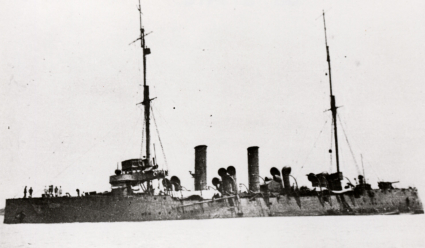
The
shock
of
this
loss
sent
a
shiver
through
the
British
Military.
Such
a
loss
so
early
in
the
war
was
seen
as
bad
for
moral
and
therefore
efforts
were made to suppress and alter the news of the battle.
The
ship
was
initially
described
as
‘disabled’
rather
than
sunk.
And
even
though
the
captain
admitted
to
intentionally
surrendering
the
ship
a
fantastic
story
of
a
lone
sailor
defiantly
holding
aloft
a
battered
flag
until
he
too
was
struck
down,
was
circulated
in
hopes
of
generating
patriotic
fever.
In
reality
38
seaman
on
the
Pegasus
and
one
on
the
Helmuth
died
that
morning.
Many
others
were
wounded.
The
dead
were
buried
on
a
small
isle in Zanzibar Harbor, That isle is still known today as Grave Island.
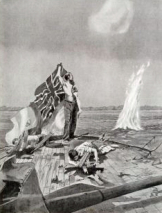
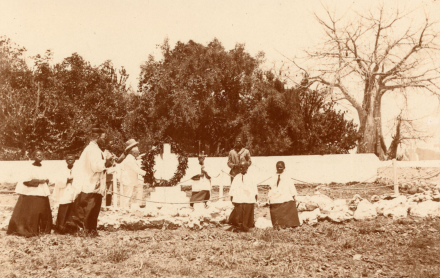
The Arab Rifles
and
The Arab Corps
in battle.
Even before all the British burials could be complete the Germans struck again.
The
next
day,
Sept.
21,
1914
some
500
troops,
with
6
machine-guns,
marched
north
from
Tanga,
out
of
German
East
Africa,
along
the
coast
and
into
British
East
Africa,
arriving
just
south
of
Mombasa, at a town named Jasin.
The
dire
threat
this
move
posed
to
Mombasa
cannot
be
exaggerated.
Mombasa
was
then
held
only
by
a
few
KAR
soldiers,
the
police
and
some
British
civilian
volunteers,
including
some
retired
naval
officers
who
reportedly
set
up
a
gun
position
in
the
old
Fort
Mombasa,
using
a
modified
signal
cannon.
However,
Mombasa
did
have
one
unique
force,
one
raised
by
a
local
Sisal
farmer
named Arthur Wavell.
Wavell
named
this
unit
the
Arab
Rifles,
but
many
others
referred
to
it
as
simply
as
Wavell’s
Arabs
.
He
had
recruited
200
Muslim
men
from
the
city,
and
pledged
to
train
and
equip
them
himself.
Arabic
and
Swahili
young
men
joined
willingly,
eager
to
serve
with
a
commander
who
showed
great
respect
and
understanding
of
Islamic
practices.
His
interest
in
Islam
began
shortly
after
his
arrival
in
Mombasa
in
1905.
That
interest
grew
and
eventually
he
undertook
a
pilgrimage
to Mecca, in 1908.
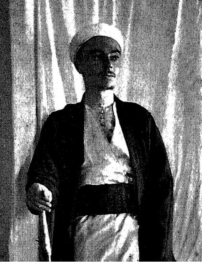
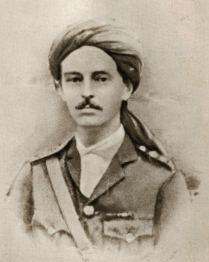
When
word
reached
Wavell
that
the
Germans
were
on
the
march
he
and
his
men
were
encamped
near
the
border,
at
a
town
named
Majoreni.
There
the
he
and
the
Arab
Rifles
had
already
been
in
action.
On
August
30th,
they
had
attacked
and
driven
the
German
frontier
guards
out
of
Jasin
town.
Since
then
they
had
worked
to
improve
the
defenses
around
Majoreni.
Now
the
Germans
had reoccupied Jasin and were clearly preparing to attack.
The
battle
of
Majoreni
started
on
September
22,
1914.
The
Germans
deployed
in
two
columns,
one
column
crossed
the
Mwena
river
and
pushed
on
to
Majoreni
where
they
encountered
the
mini-fort
that
Wavell’s
men
had
thrown
together
in
record
time.
There
the
Germans
faltered,
they
hammered
all
day
in
vain
at
the
British
redoubt
with
their
heavy
machine
guns.
Mines
hampered
any
German
attempts
to
maneuver
and
they
took
casualties
from
the
well
aimed
rifles
of
Wavell’s
men. As night fell the Germans retreated, back south across the Mwena river.
The
Arab
Rifles
had
held-out
courageously
and
they
suffered
two
men
killed
and
seven
wounded.
Among
the
wounded
was
Captain
Wavell,
he
received
a
severe
arm
wound.
Moreover
they
lacked
the
ammunition
to
continue
any
further
all-day
battles.
Therefore
the
Arab
Rifles
fell
back
the
next
day,
further
north
toward
the
town
of
Gazi.
Their
rear
guard
was
active,
slowing
and
harassing the Germans who were on the march again, north toward Mombasa.
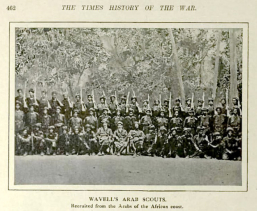
These
delays
allowed
the
British
time
to
rush
reinforcements
to
the
area.
Troops
from
India
had
finally
reached
Mombasa.
The
29th
Punjab
battalion
immediately
rushed
2
company’s
south,
they
were
soon
joined
by
2
KAR
company’s,
and
finally
Wavell’s
battered
Arab
Rifles
linked
up
to
formed a defensive perimeter near Gazi, only 22 miles from Mombasa.
The
Germans
attacked
Gazi
on
October
7th,
1914.
Four
Schutztruppe
company’s
and
the
small
Arab
Corps,
(coastal
Arabs
allied
with
the
Germans)
launched
the
assault
through
low
bush
country
and
across
plantation
fields.
The
battle
raged
all
morning,
with
the
Germans
continuing
to
advance
in
the
face
of
heavy
fire.
Then,
just
before
noon
the
KAR
men
counterattacked.
The
Germans beat off that counterattack but their own advance had halted.
While
the
Germans
paused
to
reorganize
the
British
withdrew
to
more
prepared
defensive
positions
and
refreshed
themselves
briefly.
Soon
the
Germans
renewed
their
advance.
But
again
the
KAR
men
and
the
Arab
Rifles
sprang
up
and
charged
forward
in
counterattack.
This
time
the
German
advance
collapsed
completely.
By
late
afternoon
the
Germans
were
in
full
retreat.
They
never again were able to pose a serious threat to Mombasa.
The
men
of
the
Arab
Corps,
fighting
with
the
Germans,
suffered
a
number
of
casualties
in
this
action
and
they
complained
bitterly
about
their
equipment.
They
were
armed
with
obsolete
rifles
that
were
slow
and
fired
black
powder,
that
gave
away
their
positions.
Wavell’s
Arabs
were
armed
with modern rifles that fired smokeless powder.
Many
said
that
Wavell
and
his
Arab
Rifles
had
saved
Mombasa.
Wavell
was
promoted
to
Major
and
a
public
garden
in
the
city
was
named
in
his
honor.
After
spending
some
weeks
in
hospital
Wavell
rejoined
his
men,
who
were
still
defending
the
border
just
south
of
Mombasa.
It
was
there,
later
in the war, that Major Wavell was killed in a German ambush.
The
Arab
Rifles
converted
to
a
Reserve
KAR
company
after
Wavell’s
death.
As
for
the
Arab
Corps
on
the
other
side,
they
disbanded
after
their
defeat
at
Gazi.
After
Gazi
recruiting
adequate
replacements for that unit proved impossible.
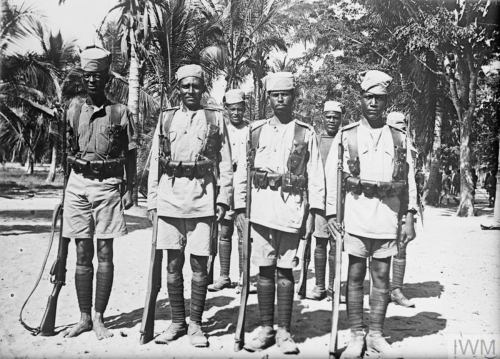
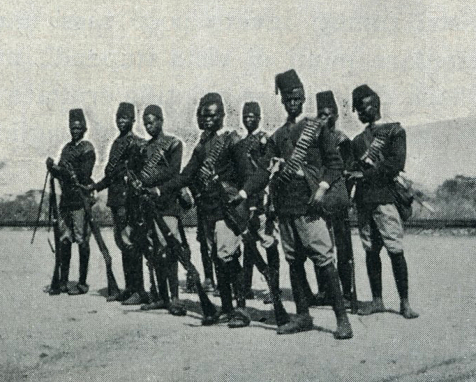
The Zanzibar Rifles and Mafia Rifles:
On
Zanzibar
the
struggle
for
Mombasa
was
followed
with
keen
interest.
The
importance
of
a
‘Home
Guard’
had
been
made
clear
to
all
in
that
fall
of
1914.
Authorities
on
Zanzibar
had
already
started
to
mobilize
all
available
manpower.
The
Police
were
militarized
and
ex-soldiers
were
called
back
into
the
ranks.
In
March
27,
1915
Captain
G.
C.
Denton
of
the
Indian
Army
was
appointed
commander
of
‘all
troops
in
the
Zanzibar
Protectorate’.
These
troops
were
called
the
“
Zanzibar
Town
Guard
”
A
month
later
Captain
Denton
changed
his
commands
name
to
the
“
Zanzibar
Volunteer Defense Force
.”
Eight
months
later,
on
Dec.
7th
1915,
Denton
was
reassigned
and
Mr.
Robert
Withycomb
was
given
command
of
the
ZVDF
and
commissioned
Lieutenant.
In
Feb
2016,
the
ZVDF
was
officially
amalgamated
with
a
company
of
“Zanzibar
Civil
Native
Police”
and
thereby
grew
to
a
total
of
four
platoons
(and
a
band).
The
platoon
commanders
appointed
that
February
were
“Temporary
Second
Lieutenant’s”
B.
C.
Johnson,
S.
River-Smith,
S.
P.
Bland
and
Lt.
Commander
Allen
Milbourn
Clark. (RN retired).
The
last
man,
Allen
Clark,
is
an
enigmatic
figure
in
Zanzibar
history.
He
took
up
X
different
assignments for Zanzibar during the war
MORE TO COME.
Website still under construction.
2018






















































